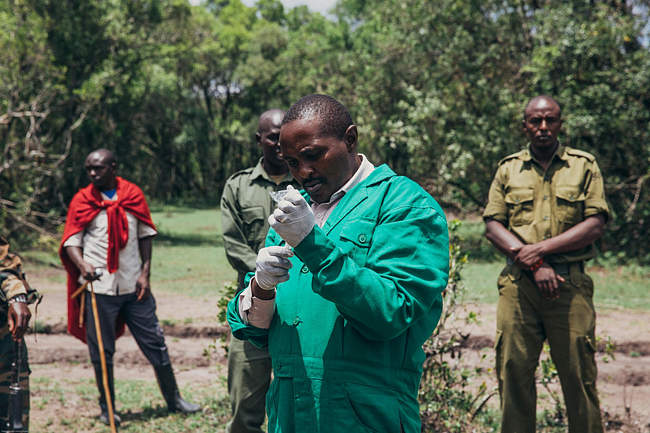Late on 27th February, DSWT CEO Angela Sheldrick received a call from KWS and then from Marc Goss of the Mara Elephant Project about an injured elephant in the Trans Mara, which was reported to be almost immobile and a victim of increased human-wildlife conflict in the region
Late on 27th February, DSWT CEO Angela Sheldrick received a call from KWS and then from Marc Goss of the Mara Elephant Project about an injured elephant in the Trans Mara, which was reported to be almost immobile and a victim of increased human-wildlife conflict in the region.
With the DSWT/KWS Mara Mobile Veterinary Unit away taking their due off days, plans were set in motion for Sky Vet to assist and at 10.30am on 28th February, KWS Vet Dr. Njoroge and his assistant took off from Wilson airport for the 45 minute flight to the nearest airstrip to the injured animal. Met on arrival by Mara Conservancy Rangers, it became apparent that while the elephant was close by, as the bird flies, there was the issue of finding a point to cross the Mara River. The team met up with Marc Goss and while the Vet remained with Marc to hatch a plan and get his equipment ready, a Mara Elephant Project vehicle loaded with extra equipment and Rangers drove the bumpy 50 minutes to the scene.



The elephant was being monitored all the time by conservancy rangers and while it appeared to be seriously injured, it was in fact mobile and had moved into a forested area. Marc and Dr. Njoroge arrived to the scene by helicopter, having hoped to find the elephant in more of a clearing, which would have allowed for darting from the air. This was not to be the case and it became apparent a hike into the forest would be the only option.


Receiving assistance from local community members, who were only too happy to assist in carrying all the veterinary equipment and water that would be needed during the treatment, the team headed out. Immediately there was concern, as the elephant was not alone in the forest, it was close to about 100 other wild elephants! The Rangers chose to enter the forest and carefully seek out the injured elephant, all the while mindful of the other elephants in the area and fortunately, after a short while they located the patient.
With his tranquilizer gun prepared, the rest of the team entered the forest and for the next hour, carefully negotiated their way through the thick bush. On first sighting the elephant, a mock charge ensued, which caused quite the commotion in this confined space, before the elephant vanished into the thicket once more. Dr. Njoroge was however unperturbed in his desire to treat the animal and with two Rangers he set off again in pursuit, the rest of the team hanging back so as not to get in the way or risk spooking the elephant.
The Vet’s first darting attempt unfortunately missed the target, unsurprising given the density of the bush and he was back to prepare another dart and then set out once again. In all, it took almost an hour and a half to find and dart the elephant and all the while a brewing storm was moving ever closer, however once down, everyone snapped into action. A small stick with used to keep the elephant’s trunk, and airway, open and having fallen conveniently on its left side, its right ear was pulled over its eye and water poured over the ear to help keep the animal cool during treatment.



It was immediately apparent to Dr. Njoroge that the injury to the elephant’s right upper flank had been caused by a bullet, given the angle of entry and he set about treating the wound. Retrieving the bullet was not possible, however the important point was, it had not hit or shattered any bones. The wound was extensively treated before the Vet proceeded to inject the elephant with anti-inflammatory drugs and anti-biotics to aid healing and keep away any possible infection. Finally, healing natural green clay was applied to the wound and the team left the area to allow the Vet to give the quick acting reversal drug for the anaesthesia.



Watching from a safe distance, this elephant, aged between 14 and 16 years, thrusted it’s head twice before rising to its feet. With that, the clouds opened and in the 30 minutes it took to walk back to the waiting vehicles, all were suitably drenched, but delighted that the elephant had received treatment and these heavy rains had held back until after the event.


With the roads becoming rivers, Marc Goss stepped up once again and in two shorts flights ferried the team by helicopter back to the airstrip, ensuring the flight back to Wilson before nightfall.
Dr. Njoroge declared a very good prognosis for the elephant, stating an 85% chance of a full recovery from the injury.
Our thanks to all involved in this treatment, from the community member that first reported the injured elephant, to the Rangers and KWS Vet, who were adamant they would treat this elephant whatever it took and ensure its future survival. Incidents of Human Wildlife Conflict are on the rise, not only in the Mara, but across Kenya, with people now living in areas that were once home solely to wildlife. This is the reality of expanding human populations and with it comes a need to identify and implement Human Wildlife mitigation strategies, from the installation of fencelines, to improved farming practices; education of local populations to the purchase and management of key eco-systems – all projects the DSWT is investing in and will continue to do so with your support.





















